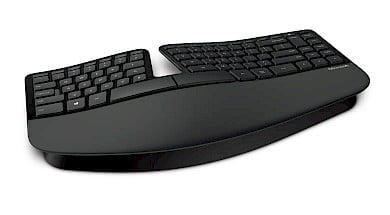To make a keyboard ergonomic, you can make sure it is as flat as possible. A flat position in the wrists can prevent RSI complaints. However, there is another option: a vertical keyboard.
A vertical keyboard often consists of 2 different parts, each of which you can position at an angle. Some variants only have an elevation in the middle. In both cases, the premise is that you don’t have to twist your forearms and wrists, which can prevent RSI.
Loose vertical keyboards
When using a loose vertical keyboard, the hands and wrists are in a natural position. This prevents the problem of pronation (turning the forearms inwards). With this keyboard, you cannot look directly at the keys, so you have to be able to type blind.
The big disadvantage of such a vertical keyboard is that it requires constant high muscle tension in the arms and hands. After all, you have to hold your hands up to type. On the contrary, it is ideal if the forearms are supported while typing, as is the case with a completely flat keyboard.
Fixed vertical keyboards
Fixed vertical keyboards get their name from a somewhat more subtle vertical angle, as shown below. They are often a lot wider than a normal keyboard due to their angle.

However, research shows that using these wide keyboards can lead to an unfavourable working posture: with the elbows turned outwards and wider apart than the shoulders. This can still cause strain. On the other hand, the strain on hands and wrists is less compared to normal keyboards.
If the keyboard has a fixed numeric part, the reaching distance to the (right-handed) mouse is also increased. This imperceptibly increases the strain on the right shoulder and wrist.
Advantages and disadvantages
Due to the vertical position of the above-mentioned keyboards, the forearms do not have to turn (provided there is a sufficient angle). And the split also keeps the wrists in an upright position while typing. These factors reduce the strain on the tendons. Due to the vertical position of the above-mentioned keyboards, the forearms do not have to turn (provided there is a sufficient angle). And the split also keeps the wrists in an upright position while typing. These factors reduce the strain on the tendons.
With fully vertical keyboards or insufficient wrist support, however, there is increased muscle strain in the hands and forearms. So pay close attention to this when making your choice. Another disadvantage is the reaching distance to the mouse with many (fixed) vertical keyboards. Finally, using a vertical keyboard requires a change in behaviour. Can’t type blind, for example? Then a vertical keyboard is not an obvious option for you.
All about ergonomic keyboards
Want to compare the vertical keyboard properly with other ergonomic options, such as the compact or split keyboard? Our whitepaper ‘Ergonomic Keyboards’ will help you make a good consideration with an overview of all pros and cons.


